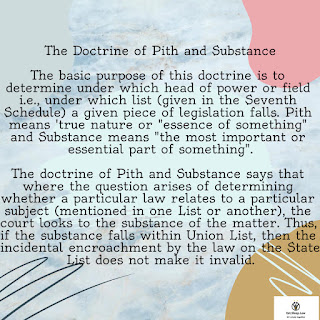The Doctrine of Pith and Substance

The basic purpose of this doctrine is to determine under which head of power or field i.e., under which list (given in the Seventh Schedule) a given piece of legislation falls Pith means 'true nature or 'essence of something and Substance means the most important or essential part of something. The doctrine of Pith and Substance says that where the question arises of determining whether a particular law relates to a particular subject (mentioned in one List or another), the court looks to the substance of the matter. Thus, if the substance falls within Union List, then the incidental encroachment by the law on the State List does not make it invalid. The Doctrine is applied when the legislative competence of a legislature with regard to a particular enactment is challenged. When a law dealing with a subject in one list touches on a subject in another list. In such a case, what has to be ascertained in the pith and substance of enactment Le. true object/purpose of l
